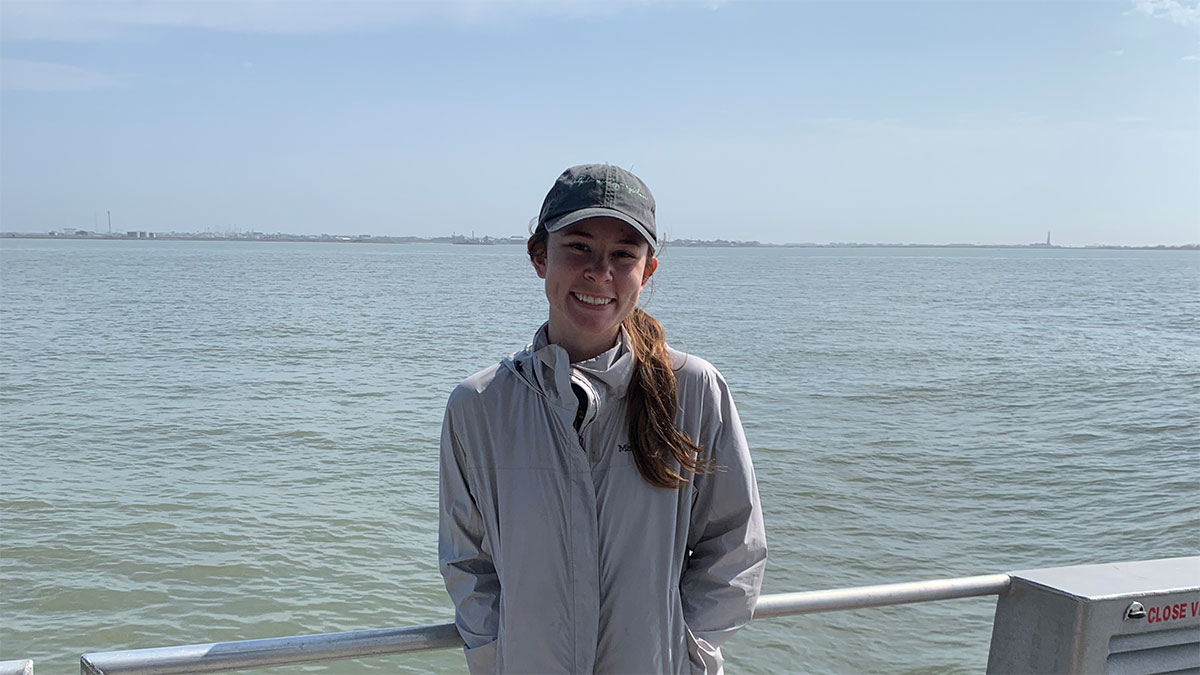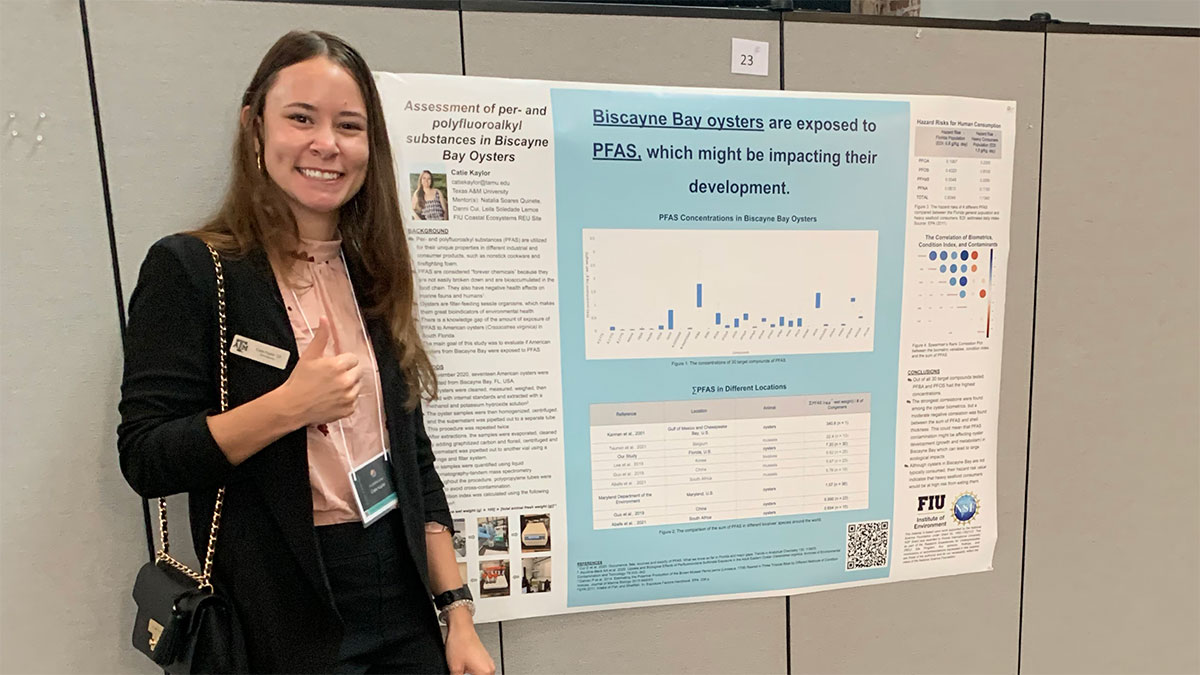
Catie Kaylor was a freshman oceanography student excited to get hands-on lab experience during her second semester at Texas A&M University when the pandemic brought in-person classes to a halt in Spring 2020. Instructors in the Department of Oceanography made the best of online learning and engaging students as much as possible, but Kaylor looked forward to getting back into the lab and onto the ocean.
At the advice of a professor prior to the pandemic, Kaylor had applied to many Research Experiences for Undergraduates (REU) sites around the country. Funded by the National Science Foundation, REU sites support summer research opportunities across a range of topics and at numerous universities. She was soon accepted to the Coastal Ecosystems REU site at Florida International University (FIU) in Miami, which was hosted by the university’s Institute of Environment. Although Kaylor’s original 2020 summer opportunity was delayed by a year due to the pandemic, in May of 2021 she was thrilled at the chance to study in Miami.
“I was learning from home for all of 2020 to 2021, so I missed out on a lot of hands-on chemistry and biology labs” she said. “Going into the REU, I felt worried and behind because I had not been in the lab setting for a while. But it turned out that this REU was the perfect opportunity to jump back into lab work. My mentors were amazing about helping me and were very supportive as I learned new techniques I'd never used before.”
When it came time to choose her research topic from the available areas of study at the REU, Kaylor chose a study researching “forever compounds” in oysters — a choice that put her on a distinct new path.
A Life-Changing Research Opportunity
Per- and polyfluoroalkyl substances, known as PFAS, are commonly used, long-lasting chemical compounds found in cookware, firefighting foam, personal care products, contaminated soil and water, and many other sources.
“PFAS do not break down easily, and that's why they're known as ‘forever compounds’,” Kaylor explained. “They bioaccumulate and don't break down.”
The project Kaylor chose that summer was investigating PFAS levels in oysters in Biscayne Bay, working with assistant professor Natalia Quinete and distinguished postdoctoral associate Leila Lemos, both researchers in FIU’s Institute of Environment and College of Arts, Sciences and Education.

“Oysters are so cool to study because they are sessile, which means they stay in one place, and they’re filter feeders, so as they eat, they are also filtering the water,” she said. “They are also bio-indicators for ecosystems, which means you can study oysters and their tissues to see what they have been exposed to in the water, because anything that’s in the water will also be in their tissues.”
The oyster samples had already been collected as part of a larger study of three locations. Kaylor’s oysters were all collected from one of those locations — the shore of FIU’s Biscayne Bay campus.
“My mentors for the most part already had the project planned out, so they taught me how to collect and analyze the data, and that made it an ideal first project for me,” she said. “I learned how to work with the oysters — cleaning, measuring, sampling, extracting and analyzing. To analyze the oysters’ PFAS levels, we ran them through the liquid chromatography tandem mass spectrometry instrument.”
From conducting hands-on research to riding across the Everglades in an airboat and spotting manatees in Biscayne Bay, Kaylor’s REU summer made a lasting impression on her.
“My summer in Miami is probably the best summer I’ll ever have,” she recalled fondly.
At the end of the summer, Kaylor presented her research in a poster and final presentation, and she also went on to present her findings at the Fluoros Global Conference in Rhode Island in October 2021.

“I was nervous to go to a conference on my own as an undergraduate, but it was a great experience, and everyone was so encouraging,” she said.
In August 2022, the research team’s findings were published in Science of the Total Environment, and Kaylor was a co-author on the news-making paper. The research was discussed by hundreds of media outlets across the country. “Scientists sample 156 Florida oysters, find dangerous ‘forever chemicals’ in each,” CBS national news reported at the time.
“I’m pursuing a career in science because I want to help answer questions and find solutions to current problems,” Kaylor said. “The day I got the email about how our paper was going viral, I was overjoyed. It was crazy to see that as an undergraduate I was already starting to make a difference.”
Pursuing Research Experience At Texas A&M
As Kaylor returned to Texas A&M, she was anxious to continue gaining research experience and skills.
“I had started working in Jessica Fitzsimmons’ lab as a bottle-cleaner [in fall 2021], which was a great next step and good lab experience,” she said. “After a semester of working hard at that job, I applied to be the Seawater Intern for the Texas A&M Oceanography Summer 2022 REU and was accepted as the intern in Fitzsimmons’ lab.”
The Texas A&M Oceanography REU program hosts 10 students each summer, and Kaylor supported their work by serving as a local peer-mentor, while also conducting her own research.
This fall she is working with Nate Lanning, Ph.D. student in the Fitzsimmons lab conducting research on colloidal trace metals in the Central Pacific Ocean, analyzing samples collected on the GP15 GEOTRACES research cruise. Colloidal trace metals are tiny particles that are considered dissolved, and they are micronutrients used by phytoplankton for important processes like photosynthesis.
“Although I’m no longer working with oysters, I am still getting to use intense chemistry, which is exciting and interesting,” she said.
Looking forward toward graduation in May 2023, she is currently applying to graduate schools and looking for opportunities to continue pursuing research.
“I feel like I’ve learned and grown so much as a young scientist and a student from my courses here and from the two REUs,” Kaylor said. “Coming to Texas A&M really has been one of the best decisions I’ve ever made.”

